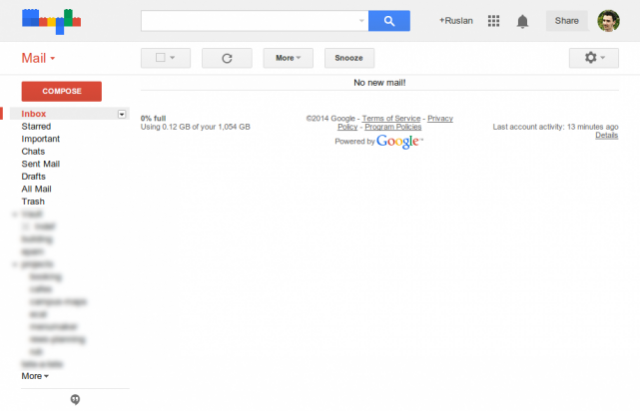Zero mail inbox
I use email a lot. Maybe not as much as some, but I receive and send a fair share of mail each day. You might find it odd, but I love using email. It’s a pleasant and calm experience, and sorting through a pile of messages every morning rewards me with a sense of achievement. There are, however, few tricks I have up my sleeve, and I would like to share them today. These tips will not necessarily make you more productive, but they will provide you a with a more pleasant and peaceful experience of managing your inbox.
But first, I would like to set the scene…
The wonderful Mailbox app
I started using iOS email client called Mailbox a little over a year ago, shortly after a release. Back then, before it was acquired by Dropbox, you had to wait in order for the company to grow their servers. I patiently waited “in line” for almost a month and I finally was able to transfer all my accounts to this wonderful mail client.
It was worth waiting for. Right after starting, Mailbox archived all the conversations in my inbox, and presented me with a list of unread emails which looked an awful lot like a To-Do list. You can read and reply, archive the important letters, delete junk, or resend a conversation to yourself after a certain time span as a reminder. This is an extremely simple idea, but it is essentially what anyone’s inbox is: a list of things which need to be done. Some emails have to be replied to, some have to be acted upon in some other way. The ones that don’t get archived are deleted right away.
Mailbox turned my trash-filled inbox into a clean list of items I need to do. Since then, there never was an email I forgot to reply to, nor an important thing I forgot to do. Inbox can be referred to as “To Do”, and an archive as “Done”. This scheme makes it nearly impossible to miss anything of importance.
Unfortunately, Mailbox is an iOS-only application, and I started noticing the shortcomings of the desktop experience. And I do use desktop mail far more often than mobile. I decided to have a set of rules for managing my inbox; and this is the workflow I have been successfully using for over a year.
Workflow outside of the Mailbox app

I only use Gmail, and there probably are ways to have the same experience on other platforms. However, the Mailbox app works only with Gmail.
The first thing which needs to be done in order to start using the zero mail inbox workflow - is to empty it from all the read mail. Thankfully, the Mailbox app archives all your previous conversations the moment you install it.
Next, there has to be a way to implement a “snooze” button. There are always times when you can’t reply to an email, but don’t exactly want to keep it in your inbox (what an eyesore). Gmail does not provide a native way to resend your emails at later times, but I found a Chrome extension called “Snooze Your Email for Gmail”, which adds a simple “Snooze” button to the Gmail UI.
Now that these two things are taken care of, there is a simple set of rules to be used when a new email comes in:
- Delete. Is it a notification? Does it require saving for future reference? A lot of things should be deleted. Bills, notifications, messages from robots: these don’t have to be saved. Items in Gmail trash live for 30 days, which is enough time to find something in case of an emergency. In addition, most of this information is available from some another source anyway.
- Snooze. Do you have time right now to read/reply/act upon this email? Remind yourself about it in a few hours or days instead.
- Archive. Conversation with a real person you might want to reference to later? I save all the email chains from humans, just in case I have to search through them at a later date.
- Reply and archive. Self-explanatory. Act upon and save for future reference.
- Let it be. This is an eyesore version of using the “Snooze” button. You usually want to do this only if there are more important emails to read and act upon before getting to this one.
Ideally, when you keep items in your inbox - this means they have to be acted upon in some way. There is no reason not to archive or delete conversations which don’t require actions.
Bonus point: labels
This is a recent addition to my repertoire. I found myself often searching through certain sets of email, and hence Gmail does not support regular expressions it’s quite a big pain in the neck for me when I can’t remember certain details. I created a set of thematic labels, which group emails by projects, products, and teams. And I started religiously assigning them to all the emails I archive. First it takes a bit of work, but after a while it becomes easy to identify a pattern and create filters to assist yourself with categorization.
As a result, I can narrow down a search to a thematic subset of emails, saving myself a lot of time and frustration.